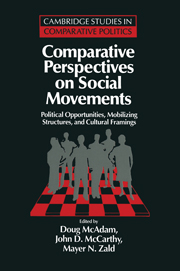 Comparative Perspectives on Social Movements
Comparative Perspectives on Social Movements Book contents
- Frontmatter
- Contents
- Biographical sketches of contributors
- Preface
- Introduction: Opportunities, mobilizing structures, and framing processes – toward a synthetic, comparative perspective on social movements
- PART I POLITICAL OPPORTUNITIES
- 1 Conceptual origins, current problems, future direction
- 2 States and opportunities: The political structuring of social movements
- 3 Social movements and the state: Thoughts on the policing of protest
- 4 Opportunities and framing in the Eastern European revolts of 1989
- 5 Opportunities and framing in the transition to democracy: The case of Russia
- PART II MOBILIZING STRUCTURES
- PART III FRAMING PROCESSES
- Notes
- References
- Index
4 - Opportunities and framing in the Eastern European revolts of 1989
Published online by Cambridge University Press: 05 June 2012
- Frontmatter
- Contents
- Biographical sketches of contributors
- Preface
- Introduction: Opportunities, mobilizing structures, and framing processes – toward a synthetic, comparative perspective on social movements
- PART I POLITICAL OPPORTUNITIES
- 1 Conceptual origins, current problems, future direction
- 2 States and opportunities: The political structuring of social movements
- 3 Social movements and the state: Thoughts on the policing of protest
- 4 Opportunities and framing in the Eastern European revolts of 1989
- 5 Opportunities and framing in the transition to democracy: The case of Russia
- PART II MOBILIZING STRUCTURES
- PART III FRAMING PROCESSES
- Notes
- References
- Index
Summary
The idea that the force of truth, the power of a truthful word, the strength of a free spirit, conscience and responsibility not armed with machine guns … might actually change something was quite beyond the horizon of [a Marxist philosopher's] understanding…Communism was overthrown by life, by thought, by human dignity. Our recent history has confirmed that.
Vaclav Havel (1992)INTRODUCTION
The year 1989, like 1848 and 1968, was a vintage year for students of collective action and social movements. One after another, like dominos, and quite unexpectedly, seemingly powerful Communist regimes were challenged and toppled in Eastern Europe by an opposition that grew within days into huge mass movements of the citizenry that demanded free elections and democracy and, except in Romania, achieved their goals without violence. Together with equally momentous events in the Soviet Union in the past few years, the 1989 revolutions spelled the end of the Cold War and started the spread of democracy beyond Western Europe. Somewhat reminiscent of 1848, when the liberal revolutions against authoritarian monarchies got confounded with nationalism, the weakening of the Soviet empire, the last colonial empire of the twentieth century, stimulated nationalist movements that led to civil war and strife in parts of the former Soviet Union and Yugoslavia. But elsewhere, the new democracies are striking root despite enormous economic problems and the pains of changing from socialism to capitalist market economies.
- Type
- Chapter
- Information
- Comparative Perspectives on Social MovementsPolitical Opportunities, Mobilizing Structures, and Cultural Framings, pp. 93 - 121Publisher: Cambridge University PressPrint publication year: 1996
- 40
- Cited by
